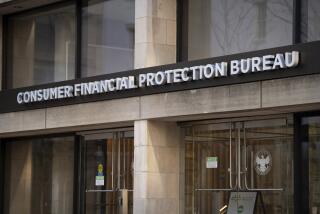U.S. Clamps Down on Loans to ‘Deadbeat’ Doctors
- Share via
WASHINGTON — Hoping to recover more than $107 million in outstanding federal student loans, government officials are withholding Medicare and Medicaid payments to so-called “deadbeat” doctors--of whom one in five practice in California.
Health and Human Services Secretary Donna Shalala released the list of 1,402 names on Tuesday, alerting health care professionals who have not begun repaying their federally guaranteed Health Education Assistance Loans. Nearly all of the debtors are doctors, with some of their loans dating back to 1979, when the loan program for students in the health care field was established.
“If they’re making any attempt at repayment, they would not be on this list,” said Claude Earl Fox, acting administrator of HHS’ Health Resources and Services Administration who unveiled the debtor list Tuesday.
Those named, he added, are individuals with whom “nothing seems to work.”
California’s share of deadbeat doctors far surpasses that of other states, with 304 professionals owing anywhere from $2,874 to a quarter of a million dollars. All but one are physicians--including psychologists, dentists, optometrists, pharmacists and foot doctors--and nearly two-thirds are chiropractors.
Topping the debtor list among the Californians is Ray Douglas, a general practitioner who the government said owes $274,716 since 1986 for his studies at Meharry Medical College in Nashville. Government records showed him as residing in Hawthorne, but a check of the local directory found no listing for him.
Other states with high numbers of defaulters are Florida, Georgia, New York, Pennsylvania and Texas. The full list of names will appear in the Federal Register this week and was posted Tuesday on the department’s Web site (www.defaulteddocs.dhhs.gov).
Under the announcement, the defaulters are barred from serving the 74 million elderly, disabled and low-income Americans covered by the federal Medicare and Medicaid health insurance programs.
The list was also forwarded to the Department of Justice, which could pursue litigation and enforce collection by garnishing wages, attaching property and seizing bank accounts. Additionally, debtors could see their tax refunds withheld and their names reported to credit bureaus.
After similar disclosures in 1993 and 1995 of the names of those who had failed to pay their so-called HEAL debts, the government recovered about $32 million.
The list is continually revised to include anyone who has made no sign of repayment in at least three years. Getting off the list can be as simple as working out a pay schedule.
“All we want them [to do] is to make some effort to repay these loans and get the process started,” Fox said.
HEAL loans are made by private and state lending institutions, including private banks, pension funds and credit unions, and are administered by the Health Resources and Services Administration. As the federal guarantor, the administration must pay the lender if students default.
Since it was established in 1979, the HEAL program has helped more than 160,000 students pay for education in the health professions.
More to Read
Sign up for Essential California
The most important California stories and recommendations in your inbox every morning.
You may occasionally receive promotional content from the Los Angeles Times.










